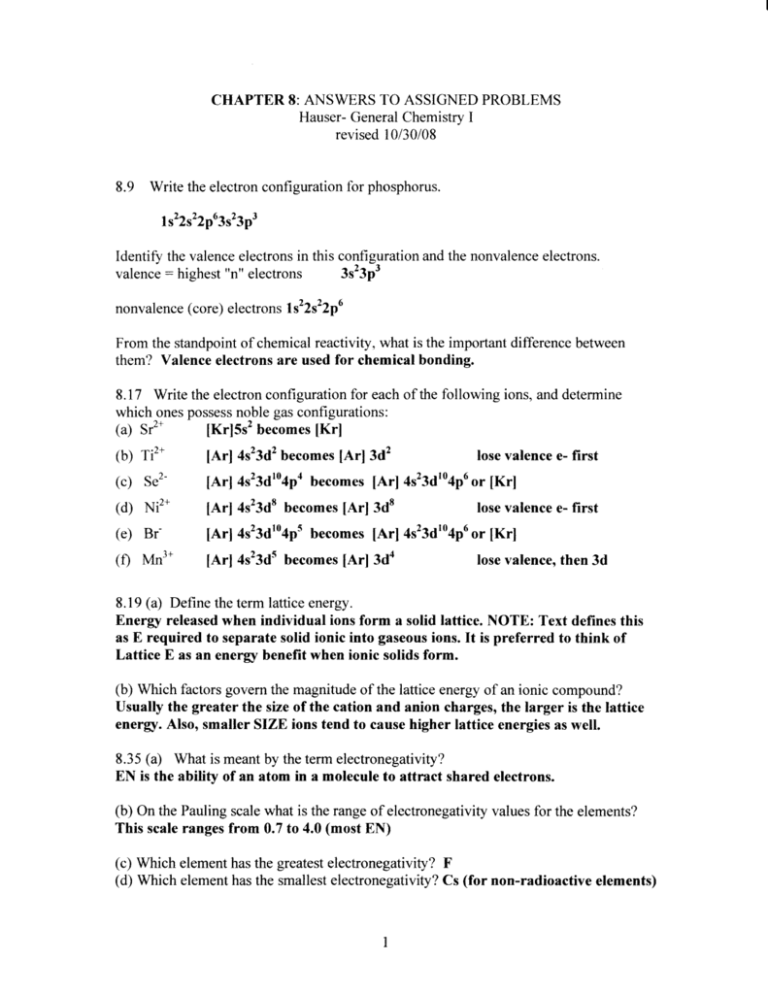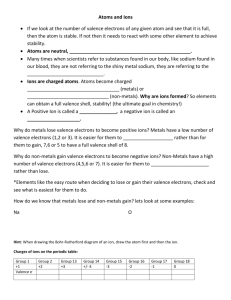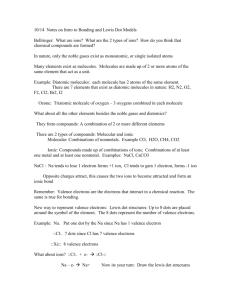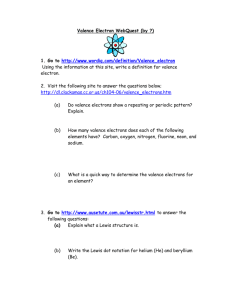Chapter 8
advertisement

CHAPTER 8: ANSWERS TO ASSIGNED PROBLEMS
Hauser- General Chemistry I
revised 10/30/08
8.9
Write the electron configuration for phosphorus.
1s22s22p63s23p3
Identify the valence electrons in this configuration and the nonvalence electrons.
valence : highest "n" electrons 3s23p3
nonvalence (core) electrons lsz 2s22p6
From the standpoint of chemical reactivity, what is the important difference between
them? Valence electrons are used for chemical bonding.
8.17 Write the electron configuration for
each of the following ions, and determine
which ones possess noble gas configurations:
Sr2*
0) Ti2*
(c) Se2(d) Ni2*
(e) Br(0 Mn3*
(a)
[Krl5s2 becomes [Krl
[Ar]
4s23dt b"comes
[Arl
3d2
lose valence e-
first
[Arl 4s23dto4p' b"comes [Ar] 4s23dr04p6 or [Kr]
lose valence e- first
[Arl 4s23dt becomes [Arl 3d8
[Arl 4s23d'o4p' becomes [Arl
[Arl
4s23do
4s23dr04p6
b".o-.r [Ar] 3da
or [Krl
lose valence, then 3d
8.19 (a) Define the term lattice energy.
Energy released when individual ions form a solid lattice. NOTE: Text defines this
as E required to separate solid ionic into gaseous ions. It is preferred to think of
Lattice E as an enerry benefit when ionic solids form.
(b) Which factors govern the magnitude of the lattice energy of an ionic compound?
Usually the greater the size of the cation and anion charges, the larger is the lattice
enerry. Also, smaller SIZE ions tend to cause higher lattice energies as well.
8.35 (a) What is meant by the term electronegativity?
EN is the ability of an atom in a molecule to affract shared electrons.
(b) On the Pauling scale what is the range of electronegativity values for the elements?
This scale ranges from 0.7 to 4.0 (most EN)
(c) Which element has the greatest electronegativity? F
(d) Which element has the smallest electronegativity? Cs (for non-radioactive elements)
8.37 Using only the periodic table
as
your guide, select the most electronegative atom in
each of the following sets:
EN increases left to right
TREND:
EN decreases top to bottom
DE.REASES
I
EN
+
O,In
(b) Al, Ca, C, Si
(c) Ge, As, P, Sn
(d) Li, Rb, Be, Sr
(a) Se, Rb,
INCREASES
O
C
P
Be
(a) How does a polar molecule differ from a nonpolar one?
polar
molecule contains area of positive and negative charge (dipote). Nonpolar
A
molecules may have polar bonds, but there is no overall dipole.
8.79
(b) Atoms X and Y have different electronegativities. Will the diatomic molecule
necessarily be polar? Explain.
This diatomic molecule will not have symmetric pulls since there are differing
electronegativities. It must be polar.
8.45 Draw Lewis structures for the following:
(a)
siHa
8
H
t
il
valence
_s; -- H
I
,-{
(b)CO
lOvalence
. rf..*.
\-U,
c
f i
{t
(c)SFz
20valence
(e) ClOz-
7*6=6*1=20valence
f F-
rv
S-F,o
e
€ (r
[ti- +-g,l
Vr-v.A-- nc
8.49 Write Lewis structures that obey the octet rule for each of the following,
and assign
formal charges to each atom:
5 6-l-+
[:u =o;] "
s6
Jl
tc vtftc.^r-r
(a) NO"
oft
;6:O
(
o'
nt'
(b) POCI3 (P is bonded to the three Cl atoms and to the O)
t+ bt at-- 3J. vcitc,\c r
*
i
I
l(,
(c) CIO+-
I+ &tt 1i: j}
v,rlrnrq
t
(
I
o;
t.
C'
L
8.88
Calculate the formal charge on the indicaled atom in each of the followin"
molecules or ions:
c\;
(a) the central oxygen atom in Or
lf
9()
-U
6
vqle{cq
ds
-6
==
€l
-!_
@
(9
(b) phosphorus in PFo-
98 v'rltnc(
(d) iodine in ICl3
1? v r\[ q,\ct
l-.,r
l'F..2
l;F :
L'-
1(
c C
tf
o-c:
= 6a
ts
v
-(
zrTr
(-v -L
c,
VE5
o
vQA:b
r
t!
;
La:
., '"
I
I C_Q- r
t !
.'rt.
('-
-
c.n-:
ir
I v€1-Yel
7
@
8.61
Draw the Lewis structures for each of the following ions or molecules. Identiff
those that do not obey the octet rule, and explain why they do not.
l e
_ 5 \al
t-'
(a)
t
^'
c \t/c
c!t
26 valence
H
(b) AlH3
Al..
i4'
ll r:-"
L
-
t{l* [*='=f] *
valence
cr
:i:
:F
lt(
(.'
(e) SbFs
I
I
40 valence
8.51
(a)
LESS THAN OCTET
I
6 valence
l6
a-
|"
SO32-
(c) Ns-
I
.(
tr;
(i
F:i
EXPANDED OCTET
tt
JF;
rL
Fl-N=Nl
Write one or more appropriate Lewis structures for the nitrite ion, NO2-
5+b-l 6-g1: i8uele\ce
i t*
Nlc.Li!
Ge
4
fru
lr.g
NJ-
il






